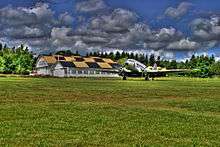Pearson Air Museum
Coordinates: 45°37′12″N 122°39′25″W / 45.620°N 122.657°W

The Pearson Air Museum is an aviation museum at Pearson Field in Vancouver, Washington, USA. Managed by the National Park Service as part of the Fort Vancouver National Historic Site, museum exhibits provide an opportunity for visitors to explore aviation history tied to Pearson Field and Vancouver Barracks. Objects and artifacts from the National Park Service collections and on loan from members of the community and other museums depict history of aviation in the Pacific Northwest.[1][2][3][4] Admission is free.
Exhibits
The National Park Service has used the museum to expand its interpretation of Army-era history at Fort Vancouver, which had not been possible within the confines of the reconstructed trading post. "A traditional Hudson's Bay post is not the best venue for an exhibit on the U.S. Army," park museum technician Meagan Huff said.[5]
The Army Boots and Army Wings exhibit highlights the history of Vancouver Barracks and the birth of Pearson Field. The displays take visitors on a journey from the post's origins in 1849, to the important regional role it played at the turn of the century, to its role as an Army Air Corps base, and beyond. The exhibit features a wide variety of archaeological and historic artifacts from the Fort Vancouver National Historic Site museum collection.[5]
The Straight-Grained Soldiers exhibit includes interpretive panels, displays of artifacts, and participatory elements tied to the aviation history of World War I in the Pacific Northwest. As military aviation transformed methods of warfare during the First World War, spruce lumber to build combat, reconnaissance, and training airplanes was in high demand. The Pacific Northwest was home to one of the world's best supplies of spruce, and so the U.S. Military created the Spruce Production Division, based out of Vancouver Barracks, to ensure that the allies would have enough spruce to produce aircraft. At its peak, the Spruce Mill, once located on the plain where Fort Vancouver and Pearson Air Museum are located today, operated 24 hours a day, 7 days a week, and produced 1 million board feet of lumber daily. The exhibit takes visitors from the entry of the United States into the war in 1917, through the creation of the Spruce Production Division and the home-front efforts undertaken in Vancouver, up to the end of the war and the birth of the Army Air Service.[3][6]
The Pearson Air Museum contains a full-scale replica of a World War I French Voisin III bomber built by Sigfried Bredl and Gerry Brown.
Setting
The Pearson Air Museum consists of two hangars in a historic setting: (1) The main hangar is a modern structure that houses the majority of the exhibits and (2) A smaller wooden hangar built in 1918. The historic hangar was built during World War I as part of the Spruce Mill and was later reused as a hangar for the Army Air Corps. The Chkalov monument, nearby, commemorates the historic Russian transpolar flight that landed at Pearson Field commanded by Valery Chkalov. Other historical buildings nearby include the headquarters building, also a reused World War I Spruce Mill Building and a historic army munitions building. Pearson Air Museum also hosts a prestigious designation from the AIAA commemorating Pearson Field's important role in many historic aviation events.
Change in management
The Pearson Air Museum was formerly managed by the Fort Vancouver National Trust. On February 5, 2013, the National Park Service ended the cooperative agreement regarding management of the museum. In response the Trust removed all privately owned artifacts from the museum (except for two aircraft that were too fragile to move). The National Park Service then reopened the museum.[7]
References
- ↑ Hardesty, Von. Historical Overview of Pearson Airfield. Unpublished manuscript, 1992
- ↑ Alley, Bill. Pearson Field: Pioneering Aviation in Vancouver and Portland. Arcadia, Charleston, SC
- 1 2 Tonsfeldt, Ward A. The U.S. Army Spruce Production Division at Vancouver Barracks, Washington, 1917-1919. Vancouver, WA: National Park Service, 2013
- ↑ Fort Vancouver NHS General Management Plan 2003 & McLoughlin House Unit Management Plan 2007
- 1 2 Vogt, Tom. Army Boots and Army Wings' bookends history at Pearson. March 29, 2013. The Columbian
- ↑ Vogt, Tom. Pearson Air Museum exhibit pays tribute to 'Straight-Grained Soldiers'. May 23, 2013. The Columbian
- ↑ http://www.columbian.com/news/2013/feb/07/group-plans-protest-pearson-air-museum/